995 scholarly books by The Institution of Engineering and Technology and 48
start with R
995 scholarly books by The Institution of Engineering and Technology and 48
995 scholarly books by The Institution of Engineering and Technology
48 start with R start with R
48 start with R start with R
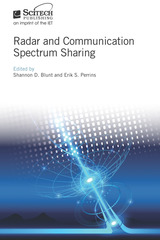
Radar and Communication Spectrum Sharing
Shannon D. Blunt
The Institution of Engineering and Technology, 2019
Radar and Communication Spectrum Sharing addresses the growing conflict over use of the radio-frequency spectrum by different systems, such as civil and security applications of radar and consumer use for wireless communications. The increasing demand for this finite resource is driving innovation into new ways in which these diverse systems can cohabit the spectrum. The book provides a broad survey of recent and ongoing work on the topic of spectrum sharing, with an emphasis on identifying the technology gaps for practical realization and the regulatory and measurement compliance aspects of this problem space. The introductory section sets the scene, making the case for spectrum access and reviewing spectrum use, congestion, lessons learned, ways forward and research areas. The book then covers system engineering perspectives, the issues involved with addressing interference, and radar/communication co-design strategies. With contributions from an international panel of experts, this book is essential reading for researchers, engineers and advanced students in radar, communications, navigation, and electronic warfare whose work is impacted by spectrum engineering requirements.
[more]
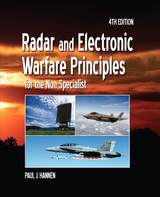
Radar and Electronic Warfare Principles for the Non-Specialist
Paul Hannen
The Institution of Engineering and Technology, 2014
This book presents a comprehensive set of radar and electronic warfare principles including many of the latest applications in a clear and consistent manner.
[more]

Radar and Electronic Warfare Principles for the Non-Specialist
Paul Hannen
The Institution of Engineering and Technology, 2014
This book presents a comprehensive set of radar and electronic warfare principles including many of the latest applications in a clear and consistent manner.
[more]
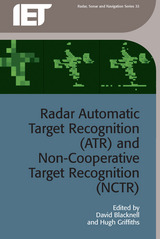
Radar Automatic Target Recognition (ATR) and Non-Cooperative Target Recognition (NCTR)
David Blacknell
The Institution of Engineering and Technology, 2013
The ability to detect and locate targets by day or night, over wide areas, regardless of weather conditions has long made radar a key sensor in many military and civil applications. However, the ability to automatically and reliably distinguish different targets represents a difficult challenge. Radar Automatic Target Recognition (ATR) and Non-Cooperative Target Recognition (NCTR) captures material presented in the NATO SET-172 lecture series to provide an overview of the state-of-the-art and continuing challenges of radar target recognition.
[more]
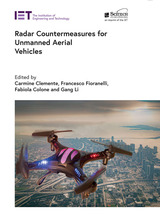
Radar Countermeasures for Unmanned Aerial Vehicles
Carmine Clemente
The Institution of Engineering and Technology, 2021
Over the last ten years, the numbers of unmanned air vehicles (UAVs) or “drones” have changed from being just a few specialist systems, used for scientific data gathering and military purposes, to them proliferating in huge numbers. They are used across a broad range of different leisure, commercial and military activities. UAVs can be used for: movement of items in factories for manufacturing, passenger and freight transportation, can take various roles in the agriculture and forestry industries (dispensing seeds, watering and monitoring crops), remote sensing for the oil and gas industries, traffic flow monitoring, support of emergency services, hobbies, security, military and many other applications.
[more]
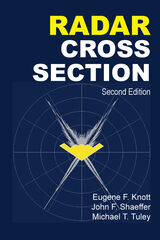
Radar Cross Section
Eugene F. Knott
The Institution of Engineering and Technology, 2004
Radar cross section (RCS) is a comparison of two radar signal strengths. One is the strength of the radar beam sweeping over a target, the other is the strength of the reflected echo sensed by the receiver. This book shows how the RCS gauge can be predicted for theoretical objects and how it can be measured for real targets. Predicting RCS is not easy, even for simple objects like spheres or cylinders, but this book explains the two exact forms of theory so well that even a novice will understand enough to make close predictions. Weapons systems developers are keenly interested in reducing the RCS of their platforms. The two most practical ways to reduce RCS are shaping and absorption. This book explains both in great detail, especially in the design, evaluation, and selection of radar absorbers. There is also great detail on the design and employment of indoor and outdoor test ranges for scale models or for full-scale targets (such as aircraft). In essence, this book covers everything you need to know about RCS, from what it is, how to predict and measure, and how to test targets (indoors and out), and how to beat it.
[more]
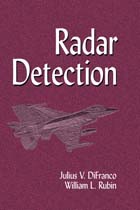
Radar Detection
Julius V. DiFranco
The Institution of Engineering and Technology, 2004
This book presents a comprehensive tutorial exposition of radar detection using the methods and techniques of mathematical statistics. The material presented is as current and useful to today's engineers as when the book was first published by Prentice-Hall in 1968 and then republished by Artech House in 1980. The book is divided into six parts. Part I is introductory and describes the nature of the radar detection problem. Part II reviews the mathematical tools necessary for a study of detection theory. Part III contains tutorial expositions in a radar context of the classical signal-to-noise and a posteriori theories, both of which have played important roles in the evolution of modern radar. The unifying theme of the book is provided by statistical decision theory, introduced in the last chapter of Part III, which provides the framework for the chapters that follow. The first three chapters of Part IV contain a unified tutorial exposition of single and multiple hit detection theory. The last two chapters are respectively devoted to the use of the radar equation and a discussion of cumulative detection probability. The latter includes a procedure for minimizing the power-aperture product of a search radar. The performance of near-optimum multiple hit detection strategies are considered in Part V. These include binary and pulse train detection strategies. The first chapter in Part VI applies sequential detection theory to the radar detection problem. It includes the Marcus and Swerling test strategy and a two-step approximation to sequential detection. The second chapter contains the development of Bayes decision rules and Bayes receivers for optimizing the detection of multiple targets with unknown parameters, such as range, velocity, angle, etc.
[more]
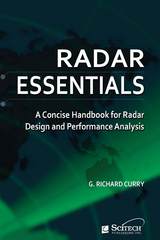
Radar Essentials
A concise handbook for radar design and performance analysis
G. Richard Curry
The Institution of Engineering and Technology, 2012
When you need vital data fast, turn to Radar Essentials. This compact yet comprehensive reference has compiled the most used principles, data, tables, and equations that are used by radar and aerospace system designers on a daily basis. Experts and non-experts alike will find this to be their go-to source for recalling and understanding the fundamentals and employing them in design and performance analysis.
[more]
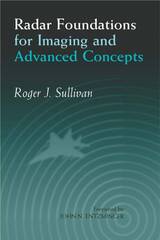
Radar Foundations for Imaging and Advanced Concepts
Roger J. Sullivan
The Institution of Engineering and Technology, 2004
Through courses taught internally at the Institute for Defense Analysis, Dr. Roger Sullivan has devised a book that brings readers fully up to speed on the most essential quantitative aspects of general radar in order to introduce study of the most exciting and relevant applications to radar imaging and advanced concepts: Synthetic Aperture Radar (4 chapters), Space-time Adaptive Processing, moving target indication (MTI), bistatic radar, low probability of intercept (LPI) radar, weather radar, and ground-penetrating radar. Whether you are a radar novice or experienced professional, this is an essential reference that features the theory and practical application of formulas you use in radar design every day. With this book, you are taken step-by-step through the development of modern airborne microwave radar, up to the cutting edge of emergent technologies including new results on theoretical 2D and 3D SAR point-spread functions (PSF) and current discussions concerning dechirp/deskew processing, layover in SAR images, vibrating targets, foliage penetration, image quality parameters, and more. Plus, for students of electrical engineering, physics, and radar, this book provides the best source of basic airborne radar understanding, as well as a broad introduction to the field of radar imaging.
[more]
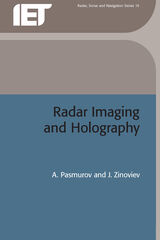
Radar Imaging and Holography
A. Pasmurov
The Institution of Engineering and Technology, 2005
Increasing information content is an important scientific problem in modern observation systems development. Radar, or microwave, imaging, a technique which combines radar techniques with digital or optical information processing, can be used for this purpose. Drawing on their own research, the authors provide an overview of the field and explain why a unified approach based on wave field processing techniques, including holographic and tomographic approaches, is necessary in high resolution radar design. Such techniques use the complex field incident on an observation surface to produce a hologram, which can be used to reconstruct an image of the object or to restore some of its physical parameters. This makes it possible to extract the size, coordinates and radar cross-section of individual scattering centres.
[more]
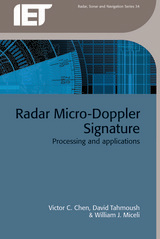
Radar Micro-Doppler Signatures
Processing and applications
Victor C. Chen
The Institution of Engineering and Technology, 2014
The micro-Doppler effect appears as Doppler frequency modulations in coherent laser or microwave radar systems induced by mechanical vibrations or rotations of a target or any part on the target. These Doppler modulations become a distinctive signature of a target that incorporates vibrating or rotating structures, and provides evidence of the identity of the target with movement.
[more]
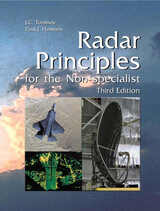
Radar Principles for the Non-Specialist
J.C. Toomay
The Institution of Engineering and Technology, 2004
Radar Principles for the Non-specialist, 3rd Edition continues its popular tradition: to distil the very complex technology of radar into its fundamentals, tying them to the laws of nature on one end and to the most modern and complex systems on the other. It starts with electromagnetic propagation, describes a radar of the utmost simplicity, and derives the radar range equation from that simple radar. Once the radar range equation is available, the book attacks the meaning of each term in it, moving through antennas, detection and tracking, radar cross-sections, waveforms and signal processing, and systems applications. At the finish, the reader should be able to do an acceptable, first order radar design and to critique the design of others. Students, engineers, scientists and managers will benefit from this book. The more noticeable enhancements to the third edition are the additions of equation numbers, more numerical examples, tables and figures showing many of the concepts numerically, and exercises for almost all of the concepts. These enhancements make the book easier to learn from and easier to teach out of.
[more]
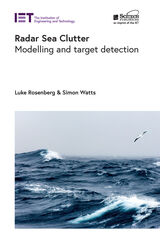
Radar Sea Clutter
Modelling and target detection
Luke Rosenberg
The Institution of Engineering and Technology, 2022
The first maritime surveillance radars in World War II quickly discovered that returns from the sea, soon to be known as sea clutter, were often the limiting factor when attempting to detect small targets while controlling false alarms. This remains true for modern radars, where the detection of small, slow moving targets on a rough sea surface remains one of the main drivers for maritime radar design, particularly in the development of detection processing.
[more]
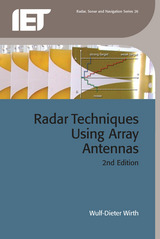
Radar Techniques Using Array Antennas
Wulf-Dieter Wirth
The Institution of Engineering and Technology, 2013
Radar Techniques Using Array Antennas is a thorough introduction to the possibilities of radar technology based on electronic steerable and active array antennas.
[more]
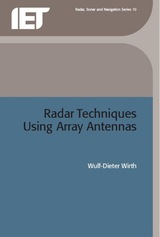
Radar Techniques Using Array Antennas
Wulf-Dieter Wirth
The Institution of Engineering and Technology, 2001
This book presents a unique and comprehensive introduction to modern radar techniques using array antennas. The author focuses upon the principles, system concepts and techniques using electronic steerable and active array antennas for future high standard multifunction radar systems in both military and civil applications. Signal processing and array antennas are discussed from an engineering perspective, as a basis for system design. The key areas covered include array signal processing, adaptive digital beamforming, adaptive monopulse, superresolution, sequential detection, SAR with an active array for moving target detection, target imaging, adaptive clutter suppression, pulse compression with low range sidelobes and high range resolution, target detection with long pulse series, energy management and system parameter relations. Several new and effective radar techniques using array antennas are also discussed based on the pioneering work conducted by the authors team at FGAN, complete with experimental simulation results. The book will prove useful for engineers and scientists who work on research, development and systems design in the radar field as well as those who are responsible for radar decision making and planning within the government or industry.
[more]
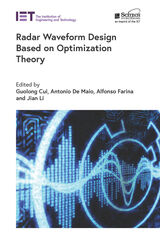
Radar Waveform Design based on Optimization Theory
Guolong Cui
The Institution of Engineering and Technology, 2020
This book provides an overview of radar waveform synthesis obtained as the result of computational optimization processes and covers the most challenging application fields. The book balances a practical point of view with a rigorous mathematical approach corroborated with a wealth of numerical study cases and some real experiments. Additionally, the book has a cross-disciplinary approach because it exploits cross-fertilization with the recent research and discoveries in optimization theory. The material of the book is organized into ten chapters, each one completed with a comprehensive list of references.
[more]

Radio Direction Finding and Superresolution
P.J.D. Gething
The Institution of Engineering and Technology, 1991
This is an enlarged and revised second edition of a book first published in 1978 and reprinted twice since then. The new edition includes updates to all the original chapters, plus two new chapters on developments in superresolution techniques and their application to direction-finding arrays.
[more]
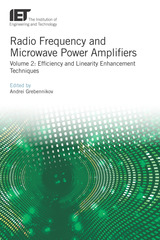
Radio Frequency and Microwave Power Amplifiers
Efficiency and Linearity Enhancement Techniques, Volume 2
Andrei Grebennikov
The Institution of Engineering and Technology, 2019
Radio Frequency and Microwave Power Amplifiers are finding an increasingly broad range of applications, particularly in communications and broadcasting, but also in the industrial, medical, automotive, aviation, military, and sensing fields. Each application has its own design specifications, for example, high linearity in modern communication systems or high efficiency in broadcasting, and, depending on process technology, capability to operate efficiently at very high frequencies, such as 77 GHz and higher for automotive radars. Advances in design methodologies have practical applications in improving gain, power output, bandwidth, power efficiency, linearity, input and output impedance matching, and heat dissipation.
[more]
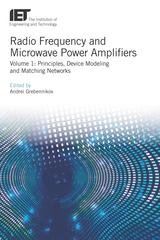
Radio Frequency and Microwave Power Amplifiers
Principles, Device Modeling and Matching Networks, Volume 1
Andrei Grebennikov
The Institution of Engineering and Technology, 2019
Radio Frequency and Microwave Power Amplifiers are finding an increasingly broad range of applications, particularly in communications and broadcasting, but also in the industrial, medical, automotive, aviation, military, and sensing fields. Each application has its own design specifications, for example, high linearity in modern communication systems or high efficiency in broadcasting, and, depending on process technology, capability to operate efficiently at very high frequencies, such as 77 GHz and higher for automotive radars. Advances in design methodologies have practical applications in improving gain, power output, bandwidth, power efficiency, linearity, input and output impedance matching, and heat dissipation.
[more]

Radio Frequency and Microwave Power Amplifiers
Theory, design and applications
Andrei Grebennikov
The Institution of Engineering and Technology, 2019
Radio Frequency and Microwave Power Amplifiers are finding an increasingly broad range of applications, particularly in communications and broadcasting, but also in the industrial, medical, automotive, aviation, military, and sensing fields. Each application has its own design specifications, for example, high linearity in modern communication systems or high efficiency in broadcasting, and, depending on process technology, capability to operate efficiently at very high frequencies, such as 77 GHz and higher for automotive radars. Advances in design methodologies have practical applications in improving gain, power output, bandwidth, power efficiency, linearity, input and output impedance matching, and heat dissipation.
[more]

Radio Frequency and Microwave Power Measurement
Alan E. Fantom
The Institution of Engineering and Technology, 1990
The need to measure electrical power is common to many branches of science and engineering. This book presents a wide-ranging survey of the many types of radio-frequency and microwave power meter and the techniques which are used for calibrating and intercomparing them. The frequency range is 1 MHz to 200 GHz.
[more]
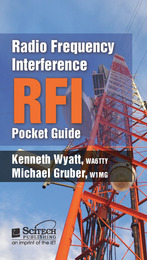
Radio Frequency Interference (RFI) Pocket Guide
Kenneth Wyatt
The Institution of Engineering and Technology, 2015
This handy pocket guide to essential radio frequency interference (RFI) is a valuable, pocket-sized reference for radio amateurs and others in the radio communication fields.
[more]
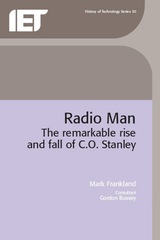
Radio Man
The remarkable rise and fall of C.O. Stanley
Mark Frankland
The Institution of Engineering and Technology, 2002
Radio Man tells the story of C.O. Stanley, the unconventional Irishman who acquired Pye Radio at the beginning of the broadcasting age. Although he started with little experience and even less money, he was to make Pye a major player in the British electronics industry - only to crash it spectacularly forty years later. From the romance of early radio to the birth of the mobile, Stanley and Pye were players in some of the key moments of twentieth century Britain. His obsession with the infant medium of television allowed Pye to provide the equipment that put radar into planes in time for the Battle of Britain. His energy also drove Pye's pioneering work on the proximity fuse - work that would revolutionise antiaircraft warfare - and the company's manufacture of the war's most successful army radios.
[more]

Radio Spectrum Management
Management of the spectrum and regulation of radio services
David Withers
The Institution of Engineering and Technology, 1999
Vast numbers of radio systems are now in use, and with new users and new uses constantly emerging, these systems have the potential to interfere with each other.
[more]
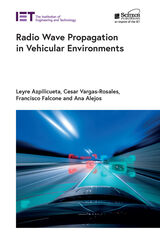
Radio Wave Propagation in Vehicular Environments
Leyre Azpilicueta
The Institution of Engineering and Technology, 2021
Providing a unified treatment of radio wave propagation in vehicular environments, this book offers a thorough discussion of their theoretical background and fundamental limits, and paves the way to a better understanding of more advanced topics. Further, the book introduces the newest challenges and problems posed by the ever growing need to communicate in mobile networks whilst in a vehicle.
[more]

Real Time Convex Optimisation for 5G Networks and Beyond
Long D. Nguyen
The Institution of Engineering and Technology, 2022
There is no doubt that we are facing a wireless data explosion. Modern wireless networks need to satisfy increasing demand, but are faced with challenges such as limited spectrum, expensive resources, green communication requirements and security issues. In the age of internet of things (IoT) with massive data transfers and huge numbers of connected devices, including high-demand QoS (4G, 5G networks and beyond), signal processing is producing data sets at the gigabyte and terabyte scales.
[more]
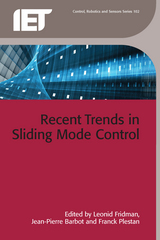
Recent Trends in Sliding Mode Control
Leonid Fridman
The Institution of Engineering and Technology, 2016
In control theory, sliding mode control, or SMC, is a nonlinear control method that alters the dynamics of a nonlinear system by application of a discontinuous control signal that forces the system to 'slide' along a cross-section of the system's normal behaviour. This book describes recent advances in the theory, properties, methods and applications of SMC.
[more]

Recommendations for Energy-efficient Exterior Lighting Systems
The Institution of Engineering and Technology
The Institution of Engineering and Technology, 2015
This good practice Guide supports informed customers and users of exterior lighting systems, providing a basis for evaluation of technical issues and decision-making on technology adoption, in order to achieve functional, budgetary and compliance requirements. It provides recommendations for decision making and appropriate approaches to the specification and procurement of energy efficient exterior lighting systems.
[more]
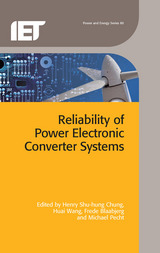
Reliability of Power Electronic Converter Systems
Henry Shu-hung Chung
The Institution of Engineering and Technology, 2016
The main aims of power electronic converter systems (PECS) are to control, convert, and condition electrical power flow from one form to another through the use of solid state electronics. This book outlines current research into the scientific modeling, experimentation, and remedial measures for advancing the reliability, availability, system robustness, and maintainability of PECS at different levels of complexity.
[more]
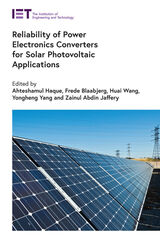
Reliability of Power Electronics Converters for Solar Photovoltaic Applications
Ahteshamul Haque
The Institution of Engineering and Technology, 2021
The importance of power electronic converters for electricity grid equipment is increasing due to the growing distribution-level penetration of renewable energy sources. The performance of the converters mostly depends on interactions between sources, loads, and their state of operation. These devices must be operated with safety and stability under normal conditions, fault conditions, overloads, as well as different operation modes. Therefore, enhanced control strategies of power electronic converters are necessary to improve system stability.
[more]
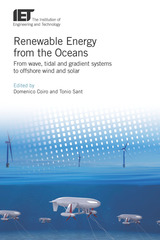
Renewable Energy from the Oceans
From wave, tidal and gradient systems to offshore wind and solar
Domenico P. Coiro
The Institution of Engineering and Technology, 2019
There are many ways to harness the renewable and emissions-free energy available from the Earth's oceans. The technologies include wave energy, tidal and current energy, and energy from thermal and salinity gradients. In addition, offshore wind energy and marine (floating) solar arrays offer a possibility to exploit vast resources that are far larger than those available onshore. The potential capacities range from many hundreds of gigawatts to terawatts of generation. These technologies could contribute a significant part of the global electricity demand; they are particularly suitable for providing sustainable power to marine regions and island communities and nations.
[more]

Requirements for Electrical Installations, IET Wiring Regulations, Eighteenth Edition, BS 7671
2018
The Institution of Engineering and Technology
The Institution of Engineering and Technology, 2018
The IET Wiring Regulations are of interest to all those concerned with the design, installation and maintenance of electric wiring in buildings. This includes electricians, electrical contractors, consultants, local authorities, surveyors and architects. This book will also be of interest to professional engineers, as well as students at university and further education colleges.
[more]

Requirements for Electrical Installations, IET Wiring Regulations, Eighteenth Edition, BS 7671
2018+A2:2022
The Institution of Engineering and Technology
The Institution of Engineering and Technology, 2022
The IET Wiring Regulations is the national standard for electrical installations in domestic, commercial and industrial settings. It is the essential standard for all those concerned with the design, installation, certification and maintenance of electrical installations. Amendment 2:2022 is a major update to BS 7671:2018, The IET Wiring Regulations, Eighteenth Edition.
[more]

Requirements for Electrical Installations, IET Wiring Regulations, Seventeenth Edition, BS 7671
2008+A3:2015
The Institution of Engineering and Technology
The Institution of Engineering and Technology, 2015
The IET Wiring Regulations are of interest to all those concerned with the design, installation and maintenance of electric wiring in buildings. The market includes electricians, electrical contractors, consultants, local authorities, surveyors and architects. This book will also be of interest to professional engineers, as well as students at university and further education colleges.
[more]

ReRAM-based Machine Learning
Hao Yu
The Institution of Engineering and Technology, 2021
The transition towards exascale computing has resulted in major transformations in computing paradigms. The need to analyze and respond to such large amounts of data sets has led to the adoption of machine learning (ML) and deep learning (DL) methods in a wide range of applications.
[more]

Resilience in Wireless Networks
Prashant Krishnamurthy
The Institution of Engineering and Technology, 2025
Resilience in Wireless Networks is the first book to cover this topic at an advanced level. It provides a unified view of the latest research and illustrates the issues, challenges and solutions currently under discussion. The book divides wireless networks into infrastructure and ad hoc topologies and considers the resilience of each separately.
[more]

Restoring Baird's Image
Donald F. McLean
The Institution of Engineering and Technology, 2000
John Logie Baird, Britain's foremost television pioneer, experimented with video recording onto gramophone discs in the late 1920s. Though unsuccessful at the time, his experiments resulted in several videodiscs, some 25 years before the videotape recorder became practical. These videodiscs - called Phonovision - remained neglected over the decades, considered by experts as unplayable.
[more]

Retro-reflective Beamforming Technique for Microwave Power Transmission
Mingyu Lu
The Institution of Engineering and Technology, 2024
Microwave power transmission technology, which is a sub-discipline of the wireless power transmission technology, aims to transmit electrical power without using wires/cables in the microwave frequency band. The retro-reflective beamforming technique has the potential to enable efficient and safe microwave power transmission, as it includes the following two technical elements. First, a directional microwave beam is generated as the carrier of wireless power. Second, the microwave power beam could be steered in real time toward mobile wireless power receiver(s). This book offers a comprehensive narrative of retro-reflective beamforming in the context of microwave power transmission.
[more]
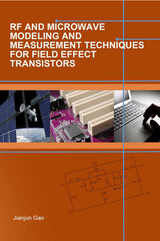
RF and Microwave Modeling and Measurement Techniques for Field Effect Transistors
Jianjun Gao
The Institution of Engineering and Technology, 2010
This book is an introduction to microwave and RF signal modeling and measurement techniques for field effect transistors. It assumes only a basic course in electronic circuits and prerequisite knowledge for readers to apply the techniques and improve the performance of integrated circuits, reduce design cycles and increase their chance at first time success. The first chapters offer a general overview and discussion of microwave signal and noise matrices, and microwave measurement techniques. The following chapters address modeling techniques for field effect transistors and cover models such as: small signal, large signal, noise, and the artificial neural network based.
[more]
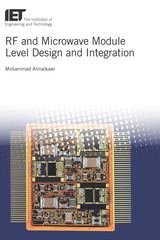
RF and Microwave Module Level Design and Integration
Mohammad Almalkawi
The Institution of Engineering and Technology, 2019
RF and Microwave Module Level Design and Integration presents a thorough introduction to the basic elements of radio frequency (RF) and microwave modules, followed by a discussion of system-level concepts and measures that can be applied to real-world designs. With a strong emphasis on design and integration, the book offers practical solutions to today's commonly encountered challenges in RF and microwave modules, including system integration, network loss reduction techniques, electromagnetic compatibility, crosstalk reduction techniques, computer-aided design tools, system-level modeling methodologies, and system-level performance evaluation via common RF measurements. Several design examples are presented across the book chapters.
[more]
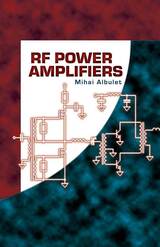
RF Power Amplifiers
Mihai Albulet
The Institution of Engineering and Technology, 2001
In this thorough overview, Mihai Albulet presents a full account of RF amplifiers and shows that understanding large-signal RF signals is simply a matter of understanding basic principles and their applications. In addition to discussing the basic concepts used in the analysis and design of RF power amplifiers, detailed mathematical derivations indicate the assumptions and limitations of the presented results, allowing the reader to calculate their usefulness in practical designs. Covered are amplification classes, circuit topologies, bias circuits, and matching networks.
[more]
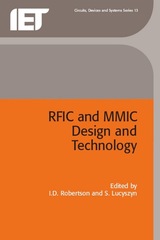
RFIC and MMIC Design and Technology
I.D. Robertson
The Institution of Engineering and Technology, 2001
RFIC and MMIC technology provides the core components for many microwave and millimetre-wave communications, radar and sensing systems. Recent years have seen exciting developments, such as circuits operating to over 200 GHz, millimetre-wave micromachined antenna arrays and microelectromechanical systems (MEMS). At the same time, the rapid growth of wireless communications in the 1 to 6 GHz range has seen a dramatic shift towards advanced silicon technology. It is timely, therefore, to introduce this fully up-to-date second edition of a world-renowned standard text.
[more]
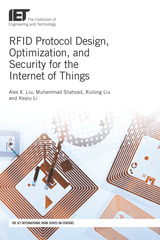
RFID Protocol Design, Optimization, and Security for the Internet of Things
Alex X. Liu
The Institution of Engineering and Technology, 2018
Radio-frequency identification (RFID) uses electromagnetic fields to automatically identify and track tags attached to objects. The tags contain electronically stored information. RFIDs have been widely used in countless applications such as object tracking, 3D positioning, indoor localization, supply chain management, automotive, inventory control, anti-theft, anti-counterfeit, and access control. The Internet of Things (IoT) promises a huge growth in RFID technology and usage.
[more]
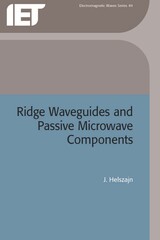
Ridge Waveguides and Passive Microwave Components
J. Helszajn
The Institution of Engineering and Technology, 2000
The ridge waveguide, which is a rectangular waveguide with one or more metal inserts (ridges), is an important transmission line in microwave engineering, through which many passive components can be achieved. As such it is a well-established and widely used element in commercial electronics and communications devices. This book collects together much of the work of Professor Helszajn, an international authoriy in the field, and will enable the reader to have direct access to this material without need for exhaustive search of research papers. Generously illustrated, it is likely to become the definitive reference source on this topic. The book includes closed-form and finite element calculations of the propagation constant, attenuation and mode spectrum for the ridge waveguide, as well as power-current and power-voltage definitions of impedance. Circular polarisation is also treated. Propagation properties where the waveguide has a dielectric filler are calculated. The treatment is then extended to more complex designs, including quadruple ridge waveguides with and without a gyromagnetic filler. The text includes descriptions of many of the passive devices which can be realised using these waveguides, including isolators, phase shifters and circulators. A treatment of the finline waveguide is included as its geometry is closely related to that of the ridge waveguide, leading to components such as the 3-port finline calculator.
[more]

Road Pricing
Technologies, economics and acceptability
John Walker
The Institution of Engineering and Technology, 2018
Road pricing is increasingly being implemented around the world to combat congestion, curb carbon and other polluting emissions, compensate for falling revenues from fuel duty, improve the efficiency of the existing transport infrastructure, and fund new transport projects.
[more]

Robots and Automated Manufacture
J. Billingsley
The Institution of Engineering and Technology, 1985
To serve its purpose, an industrial robot must be harnessed to a manufacturing task, be it welding, assembly, adjustment or the inspection of food products. Complex tasks are likely to require offline programming, both for economy of equipment use and to permit computer simulations for collision avoidance. Vision and other sensory systems are helping to extend the capabilities of robots, while advanced programming techniques are making their use more accessible to the shop floor.
[more]
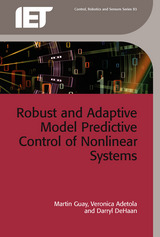
Robust and Adaptive Model Predictive Control of Nonlinear Systems
Martin Guay
The Institution of Engineering and Technology, 2016
Most physical systems possess parametric uncertainties or unmeasurable parameters and, since parametric uncertainty may degrade the performance of model predictive control (MPC), mechanisms to update the unknown or uncertain parameters are desirable in application. One possibility is to apply adaptive extensions of MPC in which parameter estimation and control are performed online. This book proposes such an approach, with a design methodology for adaptive robust nonlinear MPC (NMPC) systems in the presence of disturbances and parametric uncertainties. One of the key concepts pursued is the concept of set-based adaptive parameter estimation, which provides a mechanism to estimate the unknown parameters as well as an estimate of the parameter uncertainty set. The knowledge of non-conservative uncertain set estimates is exploited in the design of robust adaptive NMPC algorithms that guarantee robustness of the NMPC system to parameter uncertainty.
[more]

The Role of 6G and Beyond on the Road to Net-Zero Carbon
Muhammad Ali Imran
The Institution of Engineering and Technology, 2023
In the race against climate change, the focus has turned towards achieving the 2050 net-zero carbon target. Achieving net-zero means balancing between the amount of greenhouse gas removed from the atmosphere and those produced and released. Efforts are needed on both sides to find suitable solutions to reduce released emissions and to remove current emissions from the atmosphere. A collective effort revolving around the utilisation of new technologies, particularly in wireless and mobile communications, is needed to achieve the net-zero carbon target.
[more]
READERS
Browse our collection.
PUBLISHERS
See BiblioVault's publisher services.
STUDENT SERVICES
Files for college accessibility offices.
UChicago Accessibility Resources
home | accessibility | search | about | contact us
BiblioVault ® 2001 - 2024
The University of Chicago Press









